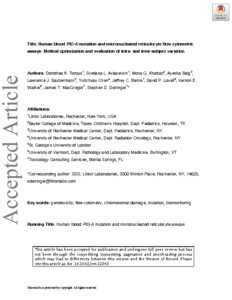Torous, DK;
Avlasevich, SL;
Khattab, MG;
Baig, A;
Saubermann, LJ;
Chen, Y;
Bemis, JC;
Lovell, DP;
Walker, VE;
MacGregor, JT;
et al.
Torous, DK; Avlasevich, SL; Khattab, MG; Baig, A; Saubermann, LJ; Chen, Y; Bemis, JC; Lovell, DP; Walker, VE; MacGregor, JT; Dertinger, SD
(2020)
Human blood PIG-A mutation and micronucleated reticulocyte flow cytometric assays: Method optimization and evaluation of intra- and inter-subject variation.
Environ Mol Mutagen, 61 (8).
pp. 807-819.
ISSN 1098-2280
https://doi.org/10.1002/em.22393
SGUL Authors: Lovell, David
![[img]](https://openaccess.sgul.ac.uk/112093/1.hassmallThumbnailVersion/em.22393.pdf)  Preview |
|
PDF
Accepted Version
Available under License ["licenses_description_publisher" not defined].
Download (5MB)
| Preview
|
Abstract
We previously described flow cytometry-based methods for scoring the incidence of micronucleated reticulocytes (MN-RET) and PIG-A mutant phenotype reticulocytes (MUT RET) in rodent and human blood samples. The current report describes important methodological improvements for human blood analyses, including immunomagnetic enrichment of CD71-positive reticulocytes prior to MN-RET scoring, and procedures for storing frozen blood for later PIG-A analysis. Technical replicate variability in MN-RET and MUT RET frequencies based on blood specimens from 14 subjects, intra-subject variability based on serial blood draws from 6 subjects, and inter-subject variation based on up to 344 subjects age 0 to 73 years were quantified. Inter-subject variation explained most of the variability observed for both endpoints (≥ 77%), with much lower intra-subject and technical replicate variability. The relatively large degree of inter-subject variation is apparent from mean and standard deviation values for MN-RET (0.15 ± 0.10%) and MUT RET (4.7 ± 5.0 per million, after omission of two extreme outliers). The influences of age and sex on inter-subject variation were investigated, and neither factor affected MN-RET whereas both influenced MUT RET frequency. The lowest MUT RET values were observed for subjects < 11 years old, and males had moderately higher frequencies than females. These results indicate that MN-RET and MUT RET are automation-compatible biomarkers of genotoxicity that bridge species of toxicological interest to include human populations. These data will be useful for appropriately designing future human studies that include these biomarkers of genotoxicity, and highlight the need for additional work aimed at identifying the sources of inter-individual variability reported herein.
| Item Type: |
Article
|
| Additional Information: |
This is the peer reviewed version of the following article: Torous, DK, Avlasevich, SL, Khattab, MG, et al. Human blood PIG‐A mutation and micronucleated reticulocyte flow cytometric assays: Method optimization and evaluation of intra‐ and inter‐subject variation. Environ Mol Mutagen. 2020; 61: 807– 819, which has been published in final form at https://doi.org/10.1002/em.22393. This article may be used for non-commercial purposes in accordance with Wiley Terms and Conditions for Use of Self-Archived Versions. |
| Keywords: |
biomonitoring, chromosomal damage, flow cytometry, genotoxicity, mutation, Toxicology, 05 Environmental Sciences, 06 Biological Sciences, 11 Medical and Health Sciences |
| SGUL Research Institute / Research Centre: |
Academic Structure > Population Health Research Institute (INPH) |
| Journal or Publication Title: |
Environ Mol Mutagen |
| ISSN: |
1098-2280 |
| Language: |
eng |
| Dates: |
| Date | Event |
|---|
| 16 October 2020 | Published | | 27 July 2020 | Published Online | | 18 June 2020 | Accepted |
|
| Publisher License: |
Publisher's own licence |
| Projects: |
|
| PubMed ID: |
32572998 |
 |
Go to PubMed abstract |
| URI: |
https://openaccess.sgul.ac.uk/id/eprint/112093 |
| Publisher's version: |
https://doi.org/10.1002/em.22393 |
Statistics
Item downloaded times since 25 Jun 2020.
Actions (login required)
 |
Edit Item |



